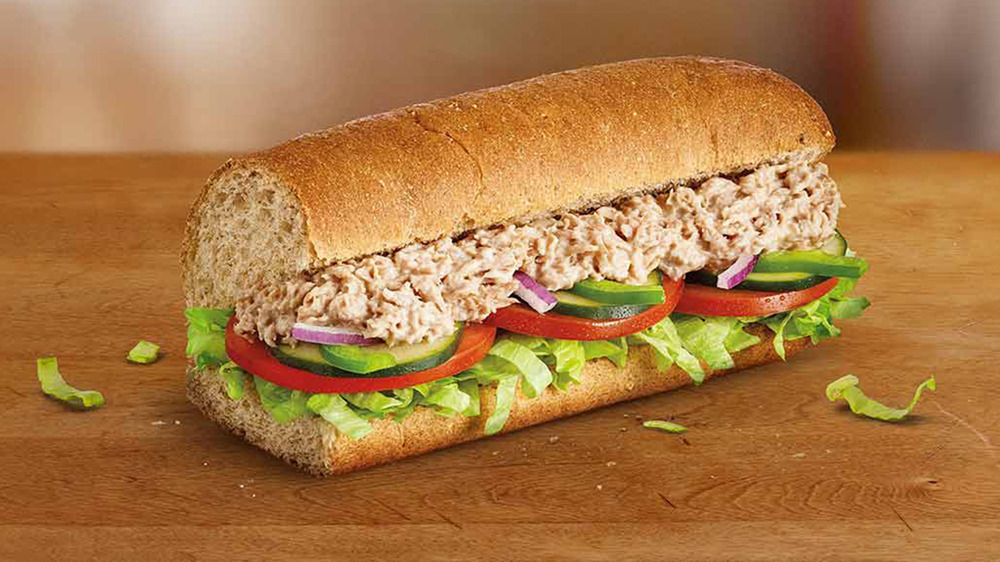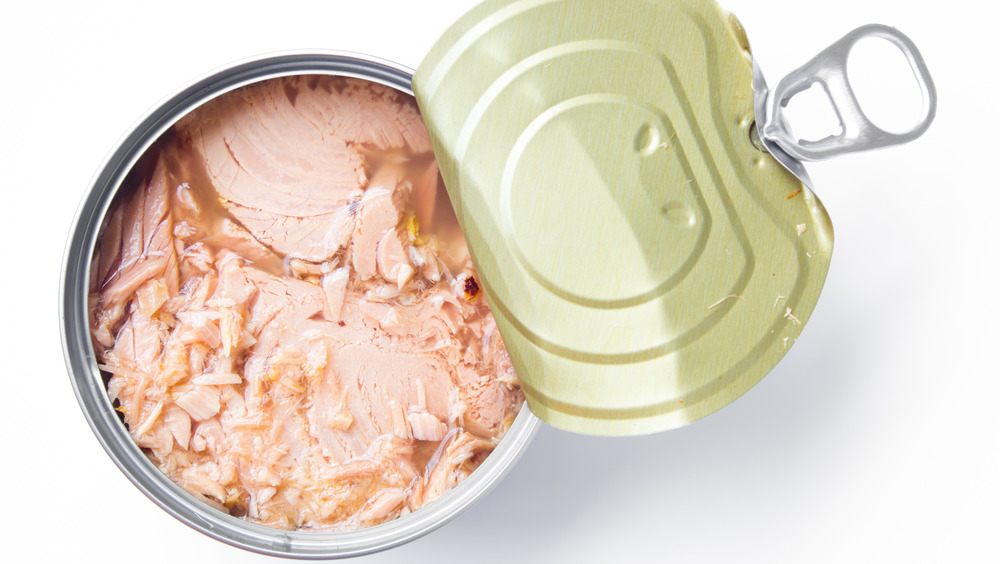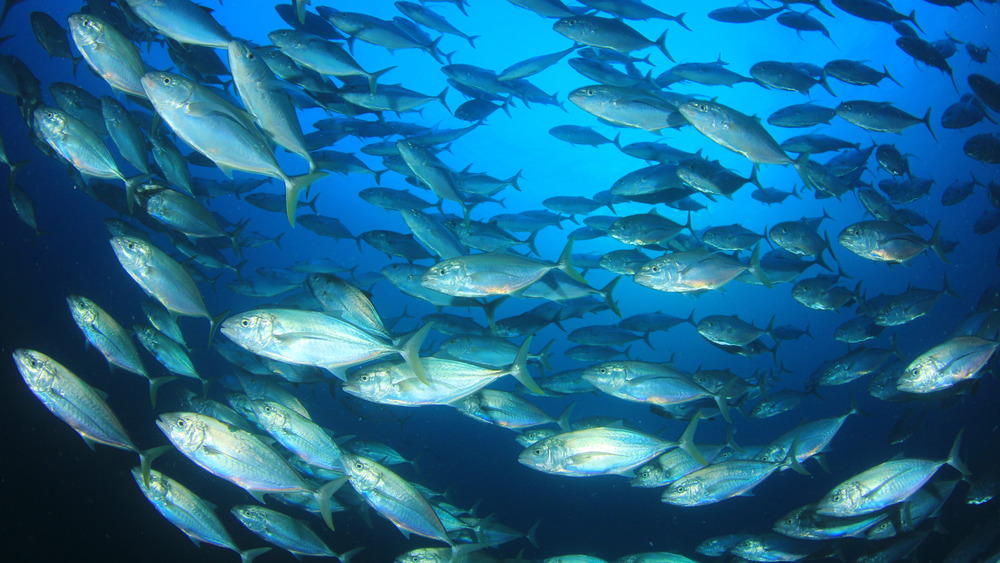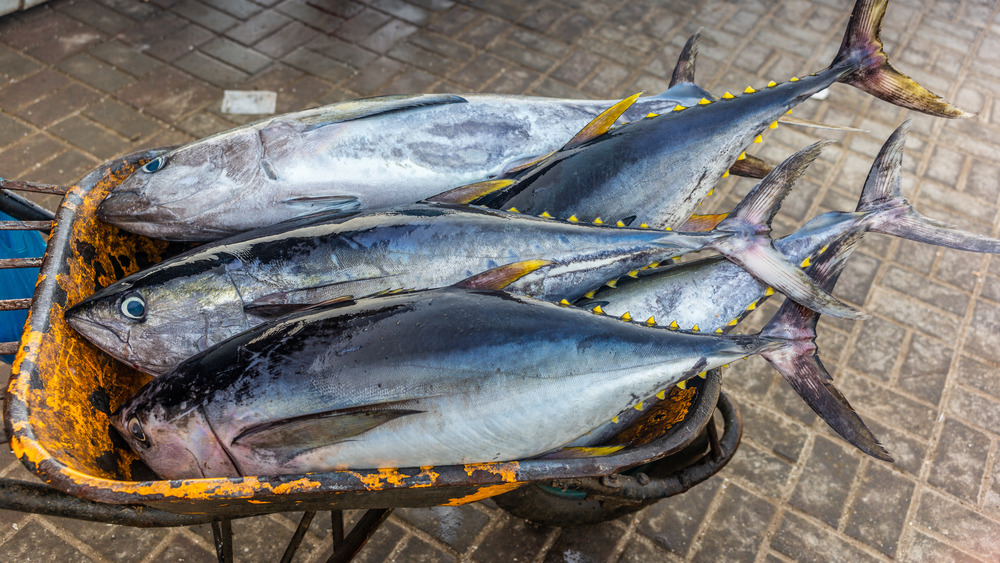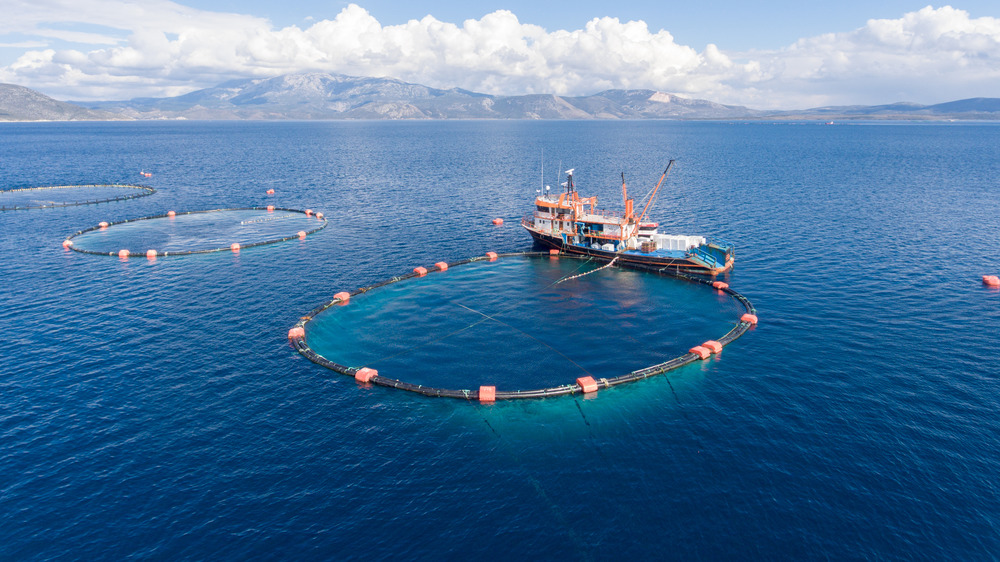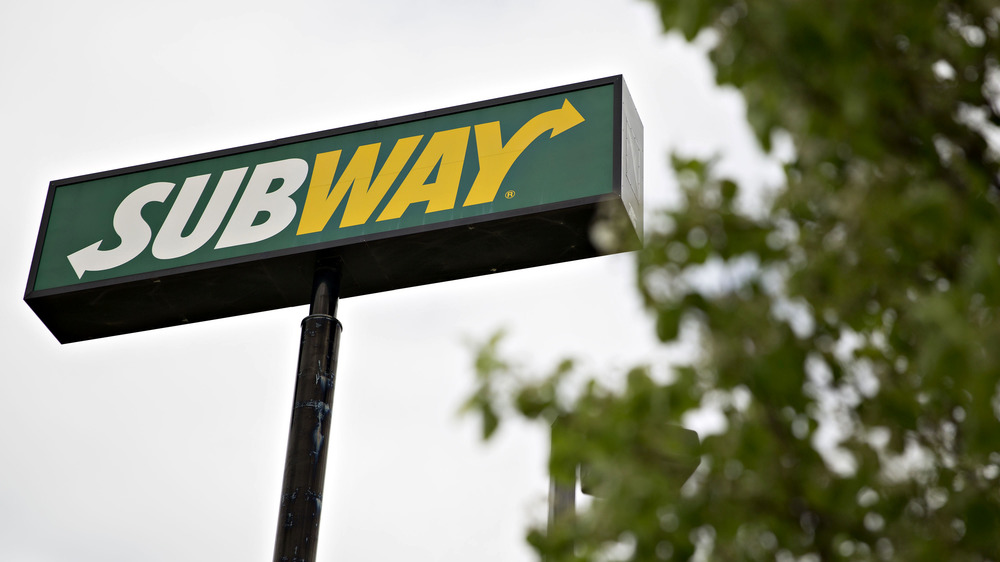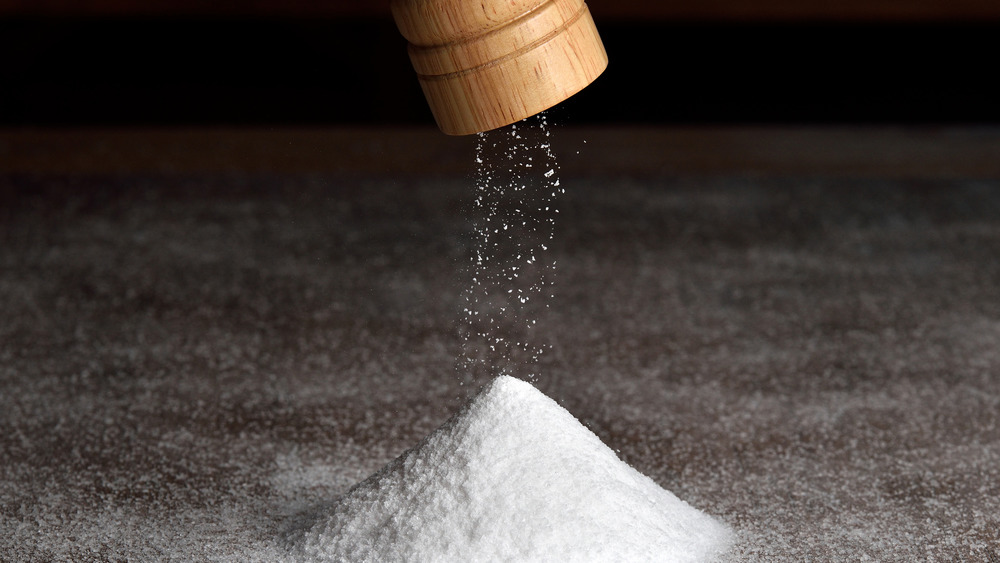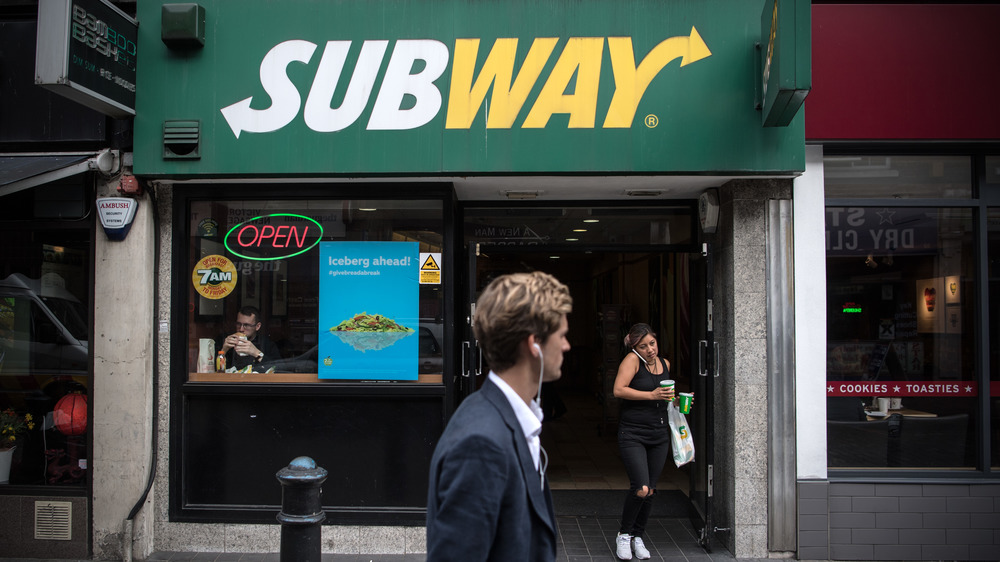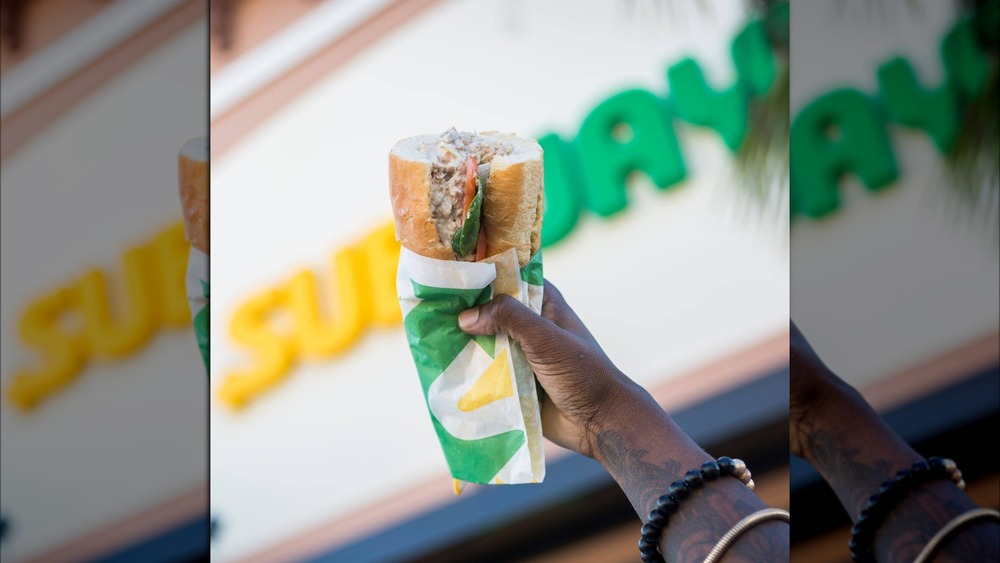The Truth About Subway's Tuna Sandwiches
Tuna salad is one of the most basic recipes of all time. Pop open a can of tuna, mix in a dollop of mayonnaise, add seasoning, and voila! And a tuna salad sandwich is almost impossible to screw up—unless, of course, you're Subway. In January of 2021, the sandwich giant got caught in a scandalous lawsuit surrounding its tuna subs. Apparently, Subway's tuna sandwich might not contain an ounce of tuna, or possibly even any type of fish — though the lawsuit doesn't lay out what, exactly, it might be instead.
Subway vehemently denies the allegations, and the restaurant chain that encourages us to "eat fresh" stands by its tuna sandwich creations. But this was not the first time the famous sandwich chain was embroiled in legal troubles. Remember when we found out that some of the ingredients in Sunway's "freshly baked" breads are also used to make yoga mats? Yum! So, what exactly is a Subway tuna sandwich made of? Here are some things about Subway's tuna sandwiches that you need to know right now – and how the latest scandal might be good for your pocketbook.
Subway says their tuna salad is made from flaked tuna
If you've ever reached for a can of tuna at the grocery store, chances are, you've been overwhelmed by the amount of options. Alongside your choice of white tuna, light tuna, and even flavored tuna, you have to also choose between solid tuna, chunk tuna, or flaked tuna. The latter is what Subway has listed in its tuna salad recipe, but what does that actually mean?
Flaked tuna is the cheapest version of canned tuna you can get, and "flaked" might mean you're not getting all that much tuna, Spoon University reports. The smaller the tuna is diced, the more it can absorb the liquid it's packed in, whether that's oil or water, and flaked tuna can absorbed up to 20 percent of the water and brine that it comes in. Subway's ingredient list indicates their tuna is packed in water, and that might not be all bad news: According to Spoon University, tuna packed in water might have more omega-3 fatty acids.
Subway's tuna salad might have 100% wild caught tuna — but there's a catch
On their website, Subway has gone above and beyond to convince people that their tuna sandwiches are made from real tuna, and not just any tuna: The franchise loudly declared on its website that their popular fish sandwich is "100% real wild caught tuna," with a bold new banner ad in tow. But you should know that wild caught doesn't always mean safe for the planet: When it comes to tuna "wild caught" usually just means that the tuna hasn't been farmed, and that doesn't mean that the fishing practices and methods deployed to catch the tuna were actually eco-friendly.
You should also know the rest of the ingredients that are inside the tuna salad, per Subway's website: The tuna salad's base is "flaked tuna in brine", which is a mix of canned tuna, water and salt. Among lemon juice, sugar, and mustard, the tuna salad also contains eggs and the preservative calcium disodium EDTA, which is considered safe by the FDA and is even used in medicine, but the FDA has set limits on its consumption (though the amount in food is generally considered safe).
Subway sells two kinds of tuna — and one of them is known for its mercury content
There are several species of tuna in our oceans, but some of them are more heavily fished than others, resulting in near-extinction. Subway has publicly claimed that it does not sell albacore, bluefin, or bigeye tuna, which all possess either critically endangered or endangered status. "We only sell skipjack and yellowfin tuna. It is sourced from fisheries with non-threatened stock levels," the company has written on its website.
Tuna is packed full of healthy omegas, good fats, and vitamins and when it's incorporated into your diet correctly, it could benefit your health. Unfortunately, tuna, more specifically canned tuna, is also known to possess considerable levels of mercury. And of the many species of tuna, yellowfin tuna is among the ones with the highest mercury content.
Canned tuna is the leading source of mercury in the diet for many people, but it's only dangerous if consumed too often. High concentrations of mercury in humans may trigger brain issues, poor mental health and heart disease. Women who are pregnant or breastfeeding should avoid consuming tuna for these reasons. While grabbing the occasional tuna sub probably won't put your body into crises, tuna and other fish which are high in mercury should be limited, according to Consumer Reports.
We don't know if Subway's tuna is dolphin-safe
Subway currently lists its commitments to social responsibility online. Alongside information detailing its farming practices, stance on palm oil harvesting, and a statement on climate change, Subway also has an animal welfare policy. However, there's no mention of sustainable fishing practices. In fact, guidelines only exist in reference to laying hens, poultry, cattle, pork, beef, and dairy cattle.
According to Epicurious, most commercial fishing is done via the purse seine method, which is basically when a fisherperson casts one giant net into the ocean and reels in the entire catch. Unfortunately, there's no way to tell what fish gets caught in the net, and oftentimes, marine species other than tuna, like sharks, turtles, and dolphins could end up getting killed in the process. While Subway says it "recognizes the vital importance of sustainable fishing – both commercially and ecologically", it does not specify if its tuna sources are labelled as dolphin-safe.
Subway's tuna sandwich could be unhealthy
If you want to cut down your meat intake, choosing a tuna sandwich might seem like a healthy alternative, and that's because it probably should be. Paired with a selection of healthy vegetables, tuna salad could be a light-weight lunch option and perfect for a quick bite to eat on the go. But at Subway, that's not exactly the case.
Of the 13 sandwiches currently offered by Subway in the U.S., the tuna sub actually contains the second-highest amount of fat (25 grams) and calories (450). The only sandwich that has it beat is the Chicken and Bacon Ranch, which weighs in at 530 calories and 26 grams of fat. Considering the Chicken and Bacon ranch sandwich contains oven-roasted chicken, bacon, Monterey cheddar cheese, and ranch sauce, this one is kind of to be expected. But who knew that a basic tuna sub without any toppings could be more unhealthy for you than the Steak & Cheese, or the Spicy Italian, especially with all of those assorted cold cuts?
Subway's tuna salad contains traces of soybeans
When you make tuna salad at home, the recipe is pretty straightforward. Once the canned tuna and mayonnaise goes in, you're pretty much done — some people like to season this salad with salt and pepper, or even chopped onion or celery, but the two main ingredients remain the same. Subway's tuna salad recipe, however, contains something a little unexpected: traces of soybeans.
In the US, soybeans have many uses and can be found in many processed foods. And as a result of this unexpected ingredient in their tuna sandwich, Subway has added the tuna sub to its US allergen chart as a warning for those with soybean allergies. If someone with a serious soybean allergy were to consume a tuna sandwich from Subway, potential reactions could include abdominal pain, nausea/vomiting, skin reactions including rashes or hives, and even difficulty breathing, according to the Mayo Clinic.
A 6-inch Subway tuna sandwich contains nearly half of the recommended daily sodium intake
According to the American Heart Association, Americans eat more than 3,400 milligrams of sodium every day, and that's more than double the ideal amount, which is no more than 1,500 mg per day for most adults. Subway's classic six-inch tuna sub on nine-grain wheat bread is recorded as having 610 mg of sodium, and if you wanted a footlong tuna sub, it would add up to about 1200 mg of sodium. And that's not only pretty close to the limit for adults, but at 900 calories for a foot-long tuna on nine-grain wheat bread, you'll most likely need more food throughout the rest of the day.
Subway's tuna sandwich also most likely increases in sodium levels depending on which bread you pick. The popular Italian Herb & Cheese bread, for example, contains 500 mg of sodium for the six-inch version, while the nine-grain bread contains 180 mg. So, if you like to go all out on the bread in your typical tuna sub order, you might want to reconsider, if salt intake is an issue.
There's another fish sandwich at Subway
If Subway's potentially fake tuna now gives you trust issues, the Seafood Sensation sub will definitely keep you up at night. Several years ago, this sandwich was apparently a major sensation, and after it was discontinued for a bit, Australian Subway fans tirelessly rallied on social media for its comeback. And some fans even swore they would never eat at Subway again, unless the Seafood Sensation returned from the depths. And come back it did, but only in select locations.
While the sandwich itself isn't listed as for sale via the online menu for all locations, its ingredients still are, and they're quite fishy: Alongside tuna, the Seafood Sensation is a strange mix of Alaskan pollock, natural crab flavor, blue crab, and snow crab meat. Imitation crab is a highly-processed concoction of minced fish (usually pollock) with starch, egg whites, sugar, salt, and additives that tries to copy the flavor, color and texture of real crab meat.
Subway tuna subs are 15% off!
While it's already one of the cheapest sandwiches on the menu, as of February 2021, Subway's tuna sandwich is currently on sale at "participating restaurants"! We can't know for sure if it's in any way related to the recent lawsuit and allegations of fake tuna, but right now, Subway is advertising a 15% discount on its footlong tuna subs. The offer is valid online or through the app but doesn't include applicable taxes or any additional add-ons and cannot be applied to the six-inch version. Using the promo code "ITSREAL", lovers of Subway's fishy sandwich can purchase a footlong for $6.79, instead of its usual price of $7.99. No other sandwiches currently have their very own promo code, and there's so fine print indicating when this promo code expires. The promo code also doesn't apply to the Footlong Pro, but there's no word yet on whether or not customers can use the promo on Subway's brand new protein bowl, which lets you turn any Footlong sub (yes, even the tuna), into a bowl.
